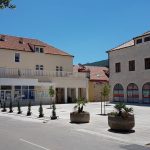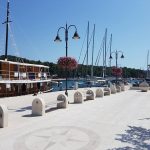Voting begins on January 18, 2018 for the best European destination for 2018, with the island of Hvar representing Croatia. Having explored Hvar’s wine story yesterday, part two of our look at the Croatian island which has it all looks at Hvar’s UNESCO heritage.
For an island which is known as the sunniest in Europe, one of the most beautiful in the world, home to the first public theatre in Europe and the birthplace of organised tourism in Europe in 1868, Hvar has quite a selection to offer guests, but did you know that it is also the island with the most UNESCO heritage in the world? Culture, tradition and heritage – Hvar has them in abundance. Here is a closer look at the FIVE pieces of UNESCO heritage through the eyes of UNESCO:
1. UNESCO World Heritage Site – Stari Grad Plain
Stari Grad Plain on the Adriatic island of Hvar is a cultural landscape that has remained practically intact since it was first colonized by Ionian Greeks from Paros in the 4th century BC. The original agricultural activity of this fertile plain, mainly centring on grapes and olives, has been maintained since Greek times to the present. The site is also a natural reserve. The landscape features ancient stone walls and trims, or small stone shelters, and bears testimony to the ancient geometrical system of land division used by the ancient Greeks, the chora which has remained virtually intact over 24 centuries.
2. Intangible UNESCO Heritage – Za Krizen (Behind the Cross) Procession
After mass on Maundy Thursday before the Christian holiday of Easter, each of six villages on the Dalmatian island of Hvar in southern Croatia sends out a group that will proceed through the other villages in a circle, covering twenty-five kilometres in eight hours before returning home. Each party in this community-organized Za Krizen (‘following the cross’) procession is led by a cross-bearer who walks barefoot or in socks, never resting. The cross-bearer, formerly selected from among religious brotherhoods and today chosen by registration up to twenty years in advance, has a much-desired and respected position, reflecting the devotion of the individual bearer and his family. He is followed by two friends with candelabra and others carrying candles and lanterns, five choral singers who sing the Lamentation of the Virgin Mary at several points along the way, and many worshippers of all ages from Croatia and abroad wearing the tunics of religious brotherhoods. The procession is greeted by the priests of each of the other five villages and returns home; the cross-bearer runs the last hundred metres to receive the blessing of his home priest. A long-established and inalienable part of Hvar religious and cultural identity, the procession connects the communities of the island to each other and to the world Catholic community.
3. Intangible UNESCO Heritage – Agava Lace from the Benedictine Nuns
At least three distinct traditions of Lacemaking in Croatia persist today, centred on the towns of Pag on the Adriatic, Lepoglava in northern Croatia and Hvar on the Dalmatian island of the same name. Pag needle-point lace was originally used to make ecclesiastical garments, tablecloths and ornaments for clothing. The process involves embellishing a spider web pattern with geometrical motifs and is transmitted today by older women who offer year-long courses. Lepoglava bobbin lace is made by braiding thread wound on spindles, or bobbins; it is often used to make lace ribbons for folk costumes or is sold at village fairs. An International Lace Festival in Lepoglava celebrates the art every year. Aloe lace is made in Croatia only by Benedictine nuns in the town of Hvar. Thin, white threads are obtained from the core of fresh aloe leaves and woven into a net or other pattern on a cardboard background. The resulting pieces are a symbol of Hvar. Each variety of lace has long been created by rural women as a source of additional income and has left a permanent mark on the culture of its region. The craft both produces an important component of traditional clothes and is itself testimony to a living cultural tradition.
4. Intangible UNESCO Heritage – Hvar’s Mediterranean Diet
Cyprus, Croatia (islands of Brac and Hvar), Spain, Greece, Italy, Morocco and Portugal
The Mediterranean diet involves a set of skills, knowledge, rituals, symbols and traditions concerning crops, harvesting, fishing, animal husbandry, conservation, processing, cooking, and particularly the sharing and consumption of food. Eating together is the foundation of the cultural identity and continuity of communities throughout the Mediterranean basin. It is a moment of social exchange and communication, an affirmation and renewal of family, group or community identity. The Mediterranean diet emphasizes values of hospitality, neighbourliness, intercultural dialogue and creativity, and a way of life guided by respect for diversity. It plays a vital role in cultural spaces, festivals and celebrations, bringing together people of all ages, conditions and social classes. It includes the craftsmanship and production of traditional receptacles for the transport, preservation and consumption of food, including ceramic plates and glasses. Women play an important role in transmitting knowledge of the Mediterranean diet: they safeguard its techniques, respect seasonal rhythms and festive events, and transmit the values of the element to new generations. Markets also play a key role as spaces for cultivating and transmitting the Mediterranean diet during the daily practice of exchange, agreement and mutual respect.
5. Intangible UNESCO Heritage – Klapa Singing in Southern Dalmatia
Klapa singing is a multipart singing tradition of the southern Croatian regions of Dalmatia. Multipart singing, a capella homophonic singing, oral tradition and simple music making are its main features. The leader of each singing group is the first tenor, followed by several tenori, baritoni and basi voices. During performances, the singers stand in a tight semicircle. The first tenor starts the singing and is followed by the others. The main aim is to achieve the best possible blend of voices. Technically, klapa singers express their mood by means of open guttural, nasal sotto voce and falsetto singing, usually in high-pitched tessitura. Another feature is the ability to sing freely, without the help of notation. Topics of klapa songs usually deal with love, life situations, and the environment in which they live. Bearers and practitioners are skilled amateurs who inherit the tradition from their predecessors. Their ages vary with many younger people singing with older singers. In ‘traditional klapa’, knowledge is transferred orally. ‘Festival klapa’ is more formally organized with a focus on performance and presentation. In ‘modern klapa’, young singers gain experience by attending performances and listening to recordings. Local communities see klapa singing as a central marker of their musical identity, incorporating respect for diversity, creativity and communication.
Have you cast your vote for Hvar as European Best Destination yet? Vote here.









